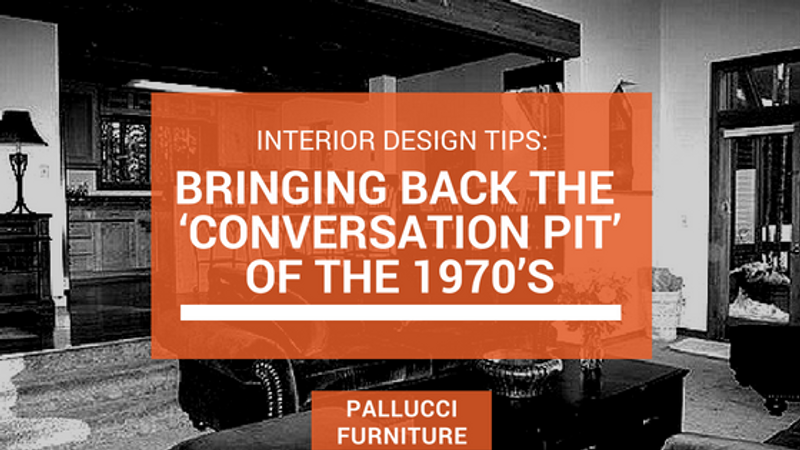
Mention ‘the 70’s’ to anyone, and you’ll likely conjure up ideals of shag carpeting, metal hair bands, sideburns, bell-bottoms, and relics of the 1960’s era of bold colours, and sputnik-inspired home décor.
The 1970’s were a great time for furniture design, as the western world seemed to be a little more open-minded to accepting concepts and aesthetics from around the globe. It was an excellent time for culturally-inspired motifs, patterns, and discussion. Cue perhaps the greatest cultural phenomenon of the 1970’s – the conversation pit.
Originally conceived by modernist architects and home designers to maximise the horizontality of their interiors and opening up the concept of uninterrupted sight-lines, these integrated rooms-within-rooms provided a sunk-in space for guests and families to enjoy each other’s company over an après dinner cup-of-cheer or morning chat.
It’s time for a comeback. In this age of constant information influx and sensory-perception overload, the concept of a conversation pit is appealing because it offers respite from the everyday. It promotes family, meaningful conversation, and time away from screens. Furthermore, they look good.
Shape & Design
The shape of a conversation pit is as varied as they come. Some photographic evidence of these long-gone design cues are rectangular, square, and even semi-circular in scope, each of them offering unique ways to interact with your guests.
A rectangular shape can allow for an elongated and relaxed aesthetic, using the length of the two longer sides to act as pseudo day-beds or a lounge inspired chaise. A square shape invites more conversation, utilising the space for discussions - and even meetings - make this an appropriate shape to include in an office revamp, or open concept living room renovation.
Semi-circular iterations may be a little out-there for most in this age of popular postmodern, symmetrical and angular design. Although they do offer an added element of togetherness, finding semi-circular furniture may be rather difficult. For this purpose, the prior suggestions make this a much more easily attainable design.
The design is quite minimal overall, contributing to this modernist style, but somewhere along the line, the conversation pit was associated with debauchery, rather than class. The incoming shag revolution shied people away from the idea of keeping conversation pits around, and they vanished from popular culture rather quickly.
Materials
Because conversation pits are often constructed below the level of the main floor, sometimes at a depth of 3 feet, mean they open the space to uninterrupted sight-lines and a clear, expanded areas. This also makes them very accessible to young children and pets.
If you’re considering which materials to use in a modern day conversation pit, consider a choice that has resilience to stains, tears and general wear-and-tear – like a bonded or genuine leather, or synthetic or polyurethane material used traditionally in outdoor furniture. This will resist the potential for spills, rips and discolouring due to use.
Another option would be to add a railing, or barrier for this type of activity, like a tempered glass, or wooden guardrail. While this adds an element of protection and safety to the space, it does tend to render the benefits of an open concept space useless.
Furniture Style
What’s best for a space dedicated to relaxation and conversation? Plush and comfy, or postmodern and sleek? This is really up to you, as it depends on what you’re building the space for in the first place.
If you’re building a modern conversation pit to replace your existing living room, a balance somewhere in between is probably best. Comfortable is a necessity, but a plush and bubbly looking mass of cushions in the middle of the room may end up looking more like a children’s nap spot, rather than a sophisticated take on a classic.
On the other hand, furniture that appears rigid and unusable can spell a space that people may feel they’re not welcome to use unabashedly. There’s a delicate balance to providing a relaxing, yet modern visual aesthetic that also promotes use and comfort. Consider looking into furniture ideas with clean, angular lines and corners that offer thick cushioning to balance out the look with for a user-friendly formula.
Another aspect to the conversation pit is lighting. Consider the practicality of a mid-hanging chandelier to illuminate the space. You could also invest in a few standing lamps to accentuate the corners of your conversation pit. Opt for warm lighting as well, rather than harsh bright lights – you’re not trying to interrogate your guests.
Elimination of TV’s and Screens
The point of these design elements today, can’t be overlooked. In a world where adults often spend over 10 hours a day looking directly at screens, the conversation pit should act as a retreat from tech, and seeks to provide its own entertainment – so get rid of the TV from the room.
While you’re at it – dive in head first to the 1970’s inspiration for the space and substitute a great record-player - or digital MP3 player, if you can’t rationalise purchasing a plethora of vinyl. The point is, give it your all to take in some quality time with friends and family. Opt for music and laughter over screen time.

